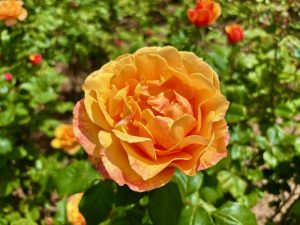Rosa ‘Pride of Cheshire’: A Bold and Beautiful Rose for the Modern Garden
Rosa ‘Pride of Cheshire’, also known as ‘About Face™’ and ‘WEKosupalz’, is a striking rose variety that instantly captures attention with its dramatic two-toned blooms. Bred by Tom Carruth in the United States before 2002 and introduced commercially in 2005, this rose has become a favorite for gardeners who enjoy bold colors, strong growth, and reliable flowering. Belonging to the Rosaceae family, it combines the old-world charm of full, globular blooms with the vigor and resilience expected from modern cultivars.
Distinctive Flower Characteristics of Rosa ‘Pride of Cheshire’
The flowers of Rosa ‘Pride of Cheshire’ are a dazzling orange blend. The petals display a deep orange-gold upper surface, contrasted beautifully by a burnished red reverse. This bicolor effect gives the blooms incredible depth, especially when the flowers are viewed in clusters against the dark green foliage. Each bloom averages 11 cm (4.5 inches) in diameter and carries 26 to 30 petals, creating a lush, full, and cupped form that recalls the grandeur of old-fashioned roses.
The buds are ovoid and pointed, opening gradually to reveal the richly colored interior. The fragrance ranges from mild to strong and often carries fruity, apple-like notes. This scent, paired with the visual drama of the blooms, ensures the rose appeals to multiple senses.
Foliage and Growth Habit
The foliage of Rosa ‘Pride of Cheshire’ is large, semi-glossy, and dark green, providing a perfect contrast to the fiery blooms. Each leaf typically carries between three and seven leaflets. The plant itself grows with a strong, upright, and well-branched habit. Mature bushes often reach 120 to 150 cm (4 to 5 feet) in height, with a spread of about 90 cm (3 feet).
Like many roses, it carries sharp thorns, so gardeners should use gloves when pruning or training stems. The structure of the plant makes it well suited for mixed borders, cutting gardens, and even as a focal point in a rose bed.
Flowering Season of Rosa ‘Pride of Cheshire’
This rose blooms in flushes from late spring until autumn. Its first display begins as temperatures rise in late spring, peaks in early summer, and then repeats in waves until the first frosts. The repeat-blooming habit makes it a valuable landscape rose, ensuring color across multiple months rather than just one short season. Gardeners who deadhead regularly will see stronger flushes and prolonged flowering.
Environmental Tolerances
Rosa ‘Pride of Cheshire’ thrives in full sun and requires at least six hours of direct light daily. In hotter climates, a touch of afternoon shade protects the blooms from scorching, but full sun produces the strongest growth and most prolific flowers. The plant adapts to a range of soils as long as they drain well. Slightly acidic conditions between pH 6.0 and 7.0 bring out its best performance.
This variety demonstrates good heat tolerance and holds its blooms well even under summer sun. In colder regions (zones 5–6), it may need winter protection, but it grows vigorously in USDA zones 7–10 without issue. Its ability to flower continuously in heat and maintain strong coloration makes it an excellent choice for modern gardens.
Landscape Uses for Rosa ‘Pride of Cheshire’
The bicolor effect of Rosa ‘Pride of Cheshire’ makes it stand out as a specimen rose. It works beautifully as a single feature shrub in a lawn bed, as part of a formal rose garden, or mixed into a perennial border where the warm tones complement purple, blue, and white flowers.
Because the blooms are large and long-lasting, this rose is also ideal for cutting gardens. The flowers hold well in vases, and their fragrance enhances indoor arrangements. Combined with its repeat blooming habit, it becomes a favorite for gardeners who enjoy both outdoor and indoor floral displays.
How to Grow Rosa ‘Pride of Cheshire’
Light
Plant Rosa ‘Pride of Cheshire’ where it receives six to eight hours of direct sunlight each day. In hotter climates, afternoon shade helps preserve bloom color, but avoid deep shade, which reduces flower production.
Soil
Choose fertile, well-draining soil enriched with organic matter. If your soil is heavy clay, lighten it with compost, aged manure, or coarse sand. In sandy soils, add organic matter to improve water retention. A slightly acidic pH of 6.0 to 7.0 works best.
Watering
Keep the soil consistently moist, especially during the first growing season. Water deeply, aiming for 2.5 to 5 cm (1 to 2 inches) per week. Adjust for rainfall and temperature. Always water at the base to keep the foliage dry, as wet leaves invite fungal issues.
Fertilizing
Feed established plants in early spring as new growth emerges. Use a balanced rose fertilizer, such as 10-10-10, and follow product instructions carefully. A second feeding after the first flush of blooms encourages repeat flowering. Continue feeding every 4 to 6 weeks until late summer. Stop fertilizing six weeks before the first expected frost to allow stems to harden for winter.
Mulching
Spread a 5 to 8 cm (2 to 3 inch) layer of organic mulch, such as shredded bark or compost, around the base. This regulates soil temperature, suppresses weeds, and locks in moisture. Keep mulch a few centimeters away from the crown to prevent rot.
Planting Rosa ‘Pride of Cheshire’
Choose a sunny location with good air circulation. Dig a hole 30 to 45 cm (12 to 18 inches) wide and just as deep. If you plant bare-root roses, create a cone of soil inside the hole to spread the roots evenly. For container-grown roses, gently loosen the root ball before planting. Position the plant so that the bud union is just above ground level in warmer regions or 5 cm (2 inches) below ground in colder regions. Backfill with a mix of native soil and compost, water thoroughly, and apply mulch.
Pruning
Prune in late winter or early spring as new growth begins. Remove dead, diseased, or damaged canes first. Then thin crossing stems to improve airflow. Cut back healthy canes by one third to one half, depending on the desired shape and size. Make clean cuts at a 45-degree angle just above outward-facing buds. During the growing season, deadhead spent blooms to encourage fresh flowers.
Propagation of Rosa ‘Pride of Cheshire’
The most reliable propagation method for Rosa ‘Pride of Cheshire’ is through cuttings. Take semi-hardwood cuttings in summer, about 15 to 20 cm (6 to 8 inches) long. Remove the lower leaves, dip the cut end in rooting hormone, and insert it into a pot filled with moist, sandy compost. Cover with a plastic dome or bag to maintain humidity. Keep the cutting in bright, indirect light until roots form. Once established, transplant into larger pots before moving outdoors.
Roses can also be propagated by budding or grafting onto hardy rootstocks, but this technique requires more skill and is usually done by professional growers.
Pests and Diseases
Like most roses, this variety can attract pests and diseases if not cared for properly.
Aphids often cluster on new growth, sucking sap and weakening stems. Spray them off with water or use insecticidal soap. Spider mites thrive in hot, dry weather and cause stippling on leaves; increase humidity and apply miticides if needed. Japanese beetles may chew flowers and leaves during midsummer; handpick them early in the day or use traps.
Powdery mildew appears as a white coating on leaves, especially in humid conditions. Prevent it by watering at the base and providing good airflow. Black spot, marked by dark circular lesions on leaves, is another common problem. Remove infected foliage promptly and apply fungicides if necessary. Rust may also occur, presenting as orange pustules on leaf undersides.
Maintaining strong cultural practices—adequate spacing, proper watering, and regular pruning—goes a long way toward preventing disease.
Winter Protection
In USDA zones 7 and above, Rosa ‘Pride of Cheshire’ typically survives winter without extra protection. In colder climates, mound soil or compost 20 cm (8 inches) around the base of the plant after the first hard frost. This insulates the crown. Remove leaves before mulching to prevent fungal spores from overwintering. In early spring, remove the mound to allow new shoots to grow.
Designing with Rosa ‘Pride of Cheshire’
This rose pairs beautifully with cool-colored perennials that offset its fiery blooms. Try planting it alongside lavender, catmint, or blue salvia. The purple-blue hues soften the intensity of the orange blend. White flowering companions such as Shasta daisies or hydrangeas also create an elegant balance.
For a dramatic effect, combine it with other roses in contrasting colors. Deep red roses provide intensity, while creamy yellow roses highlight the golden tones of ‘Pride of Cheshire’. Place it where its color can be appreciated up close, such as near patios, walkways, or garden entrances.
Tips for Success with Rosa ‘Pride of Cheshire’
- Plant in full sun for best blooms.
- Water deeply and regularly but keep foliage dry.
- Mulch yearly to enrich soil and conserve moisture.
- Deadhead spent blooms for repeat flowering.
- Prune in late winter to maintain shape and health.
- Protect in winter if grown in zones colder than USDA zone 7.
Final Thoughts on Rosa ‘Pride of Cheshire’
Rosa ‘Pride of Cheshire’, known also as ‘About Face™’ and ‘WEKosupalz’, is a remarkable rose that combines dramatic color with modern resilience. Its orange-gold blooms with red reverses stand out in any setting, while its upright growth and repeat flowering guarantee long-lasting beauty. With proper care, it rewards gardeners with months of color, fragrance, and elegance.
Whether planted as a specimen, in mixed borders, or as part of a collection, this rose justifies its name by bringing both pride and presence to the garden.



